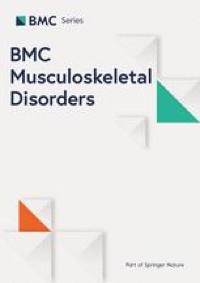|
Medicine by Alexandros G. Sfakianakis,Anapafseos 5 Agios Nikolaos 72100 Crete Greece,00302841026182,00306932607174,alsfakia@gmail.com,
Αρχειοθήκη ιστολογίου
-
►
2023
(272)
- ► Φεβρουαρίου (141)
- ► Ιανουαρίου (131)
-
►
2022
(2066)
- ► Δεκεμβρίου (80)
- ► Σεπτεμβρίου (170)
- ► Φεβρουαρίου (190)
- ► Ιανουαρίου (203)
-
▼
2021
(7399)
- ► Δεκεμβρίου (186)
- ► Σεπτεμβρίου (472)
- ► Φεβρουαρίου (851)
-
▼
Ιανουαρίου
(788)
-
▼
Ιαν 07
(50)
- Use of quantitative angiographic methods with a da...
- Reduced gray-white matter contrast localizes the m...
- Concurrent chemoradiation in locally advanced prim...
- Open synovectomy treatment for intra- and extraart...
- Patient-reported outcomes in young adults with ost...
- The association between keloid and osteoporosis: r...
- Outcomes of diverticulitis
- Poorer prognosis for neuroendocrine carcinoma than...
- Numerical joint invariant level set formulation wi...
- Deblur and deep depth from single defocus image
- MiR-501-3p promotes osteosarcoma cell proliferatio...
- Anesthetic management of unruptured intracranial a...
- Serious adverse events with novel beta-lactam/beta...
- Orthognathic surgery in class II patients: a longi...
- Efficacy of platelet-rich fibrin compared with tri...
- Modulation of TNFR 1-triggered two opposing signal...
- An overview of opioid usage and regional anesthesi...
- A novel partition selection method for modular fac...
- Fast approach for moving vehicle localization and ...
- Ultrasound evaluation of ductal carcinoma in situ ...
- Comparison of testicular vascularity via superb mi...
- Ultrasound evaluation of the first finger’s sesamo...
- Contrast-enhanced ultrasound features of breast ca...
- Air bronchogram integrated lung ultrasound score t...
- Smoothed particle hydrodynamics simulation of biph...
- Closure of Gastrointestinal Fistulas and Leaks wit...
- Trans-pulmonary closure of an aorto-pulmonary wind...
- Increasing role of cardiac surgeons in managing ca...
- Modulation of TNFR 1-triggered two opposing signal...
- Relationship between clinicopathologic factors and...
- SH2 domain-containing protein tyrosine phosphatase...
- Effective clearance of uremic toxins using functio...
- Therapeutic approach for global myocardial injury ...
- The clinical efficacy and safety of single-agent p...
- Mesenteric Venous Thrombosis Due to Coronavirus
- Lymphatic filariasis
- Regulation of human THP-1 macrophage polarization ...
- PCR-based diagnosis is not always useful in the ac...
- Characterization and localization of antigens for ...
- Periorbital human dirofilariasis
- How I do it: Management of venous bleeding from th...
- Familial tendency in patients with lipoma of the f...
- Wip1 Aggravates the Cerulein-Induced Cell Autophag...
- Decreased expression of TRIM3 gene predicts a poor...
- Safety and tolerability of regorafenib:
- Gastric Cancer Incidence and Mortality in French G...
- Endoscopic Ultrasonography is a Promising Tool for...
- Endoscopic Ultrasound-Guided Ethanol Injection Ass...
- TERRA Gene Expression in Gastric Cancer: Role of h...
- Immunohistochemical Expression Pattern of MLH1, MS...
-
▼
Ιαν 07
(50)
-
►
2020
(2517)
- ► Δεκεμβρίου (792)
- ► Σεπτεμβρίου (21)
- ► Φεβρουαρίου (28)
-
►
2019
(12076)
- ► Δεκεμβρίου (19)
- ► Σεπτεμβρίου (54)
- ► Φεβρουαρίου (4765)
- ► Ιανουαρίου (5155)
-
►
2018
(3144)
- ► Δεκεμβρίου (3144)
Ετικέτες
Πληροφορίες
Πέμπτη 7 Ιανουαρίου 2021
Use of quantitative angiographic methods with a data-driven model to evaluate reperfusion status (mTICI) during thrombectomy
Reduced gray-white matter contrast localizes the motor cortex on double inversion recovery (DIR) 3T MRI
|
Concurrent chemoradiation in locally advanced primary middle ear lymphoepithelial carcinoma: an effective treatment modality case report
|
Open synovectomy treatment for intra- and extraarticular localized pigmented villonodular synovitis of the knee: a case report
|
Patient-reported outcomes in young adults with osteonecrosis secondary to developmental dysplasia of the hip - a longitudinal and cross-sectional evaluation
|
The association between keloid and osteoporosis: real-world evidence
|
Outcomes of diverticulitis
|
Poorer prognosis for neuroendocrine carcinoma than signet ring cell cancer of the colon and rectum (CRC-NEC): a propensity score matching analysis of patients from the Surveillance, Epidemiology, and End Results (SEER) database
|
Numerical joint invariant level set formulation with unique image segmentation result
|
Deblur and deep depth from single defocus image
|
MiR-501-3p promotes osteosarcoma cell proliferation, migration and invasion by targeting BCL7A
|
Αναζήτηση αυτού του ιστολογίου
! # Ola via Alexandros G.Sfakianakis on Inoreader
-
Does CBD Oil Lower Blood Pressure? This article was originally published at SundayScaries." Madeline Taylor POSTED ON January 13, 20...
-
The device, cleared in Europe a couple of years ago, is used to ablate cardiac tissue as part of treatment for atrial fibrillation. It featu...
-
Overdue: a US advisory board for research integrity Overdue: a US advisory board for research integrity, Published online: 11 February 201...



